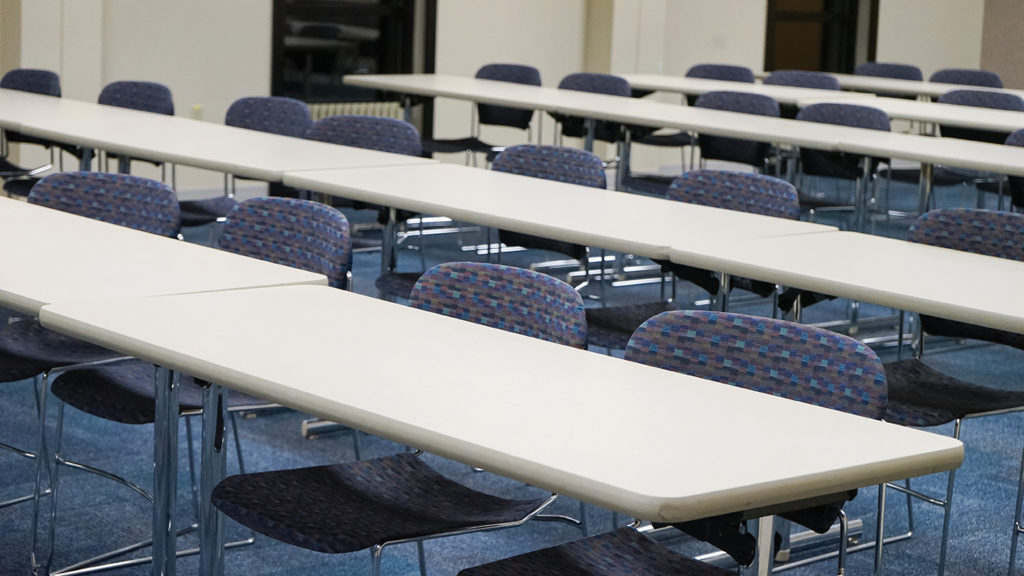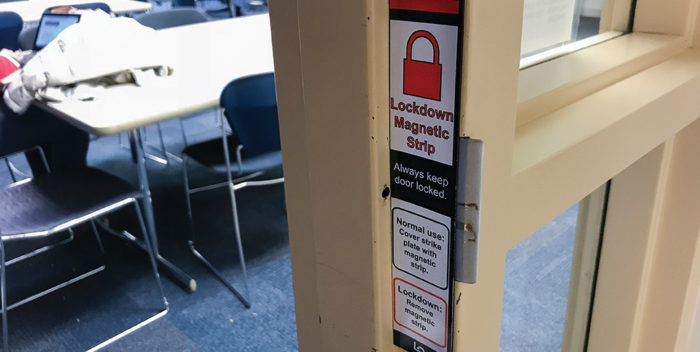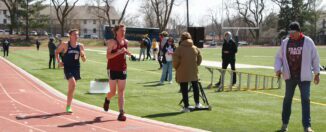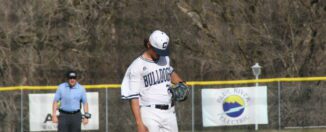Concordia’s Active Killer Policy Explained
Classrooms in the Thom Building are equipped with lockdown magnetic strips in case of active killer emergency. Photo by Kim Sleeper
by Madison Pitsch
“You can deny entry in and hide in there, because you’ll need to hold on for 15 minutes, and then you know, there’s stopping the bleeding.”
If that sounds like a line out of a spy movie, you’re wrong. That’s Tim Heidorn, assistant professor of business administration. He’s one of Concordia’s teachers that practices Concordia’s Active Killer Policy in his classrooms.
You might have even been in one of his classes during the practice. During syllabus week, he hands out the syllabus and talks about the class. He takes his laser pointer and walks out of the classroom. He then walks in, pretending to be an active killer, “spattering the classroom with the laser pointer.” This puts the students through a realistic scenario and asks them what they would do in the event of an active killer actually being on campus.
“I think that the first one in my lifetime was a gunman who went into a bell tower on the University of Texas (at) Austin campus. That was different from what we’ve been seeing more recently, Columbine High School, for example, then later on at Virginia Tech. It’s what you might call a target-rich environment,” Heidorn said. “It’s something that we should think about, simply because people hear about it on the news, and we should talk about it out loud instead of just skipping over it.”

Concordia has recently updated its active killer policy to protect the safety of students, faculty and staff. Photo by Sonja Brandt.
Heidorn then showed me how easy it is to get into some classrooms because the doors never lock.
He showed me what is called shelter-in-place, a facet of Concordia’s Active Killer Policy. It’s meant to maintain a safe classroom and avoid a hectic environment where the killer could be mixed in with the crowd and escape.
He said he would use a cable in the room to hold the door closed as well as where his students would hide in specific classrooms: behind thick walls or tables slanted on chairs to protect them when there are no thick walls.
Rehema Kavugha, director of student development and part of Concordia’s Critical Management Team, said active killer drills are beneficial for the campus community.
“It is a reality of our world and I think the biggest thing, just like everyone complains when we have to do a fire drill, the more you can practice something the better prepared you are, especially with this. There’s so many what if’s that could happen on a college campus,” Kavugha said.
Concordia recently revamped its Active Killer Policy, using the U.S. Department of Defense’s website, which has recommendations for what universities can do to be protected. They also took into account what other universities are doing and utilized local resources like Associate Professor of Biology and Criminal Justice Dr. Tim Huntington, who works for the sheriff’s department.
“We already have these partnerships, and we invite law enforcement to our campus and have them walk through different buildings… so that they are aware if something were to happen, whether it was a fire or active shooter, they’re not coming blind onto our campus,” Kavugha said.
This policy, Kavugha said, is usually not the first one students have heard of. Almost all schools in the United States have some kind of active killer policy in place. Many different policies are consistent to provide familiarity for the students.
“Sadly, now, even high schools are doing active killer training and elementary schools are doing that, so, you know, for consistency’s sake, ‘Run, Hide, Fight’ is the more popular acronym… to think in your mind if something like that were to happen, so that’s why we use that,” Kavugha said.
The policy also emphasizes student awareness. It urges students to report anything strange that they might see on campus.
If you have more questions about Concordia’s Active Killer Policy, speak with Kavugha, and if you see anything strange, please report it to campus security at 402-643-3033.














